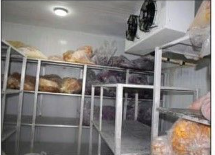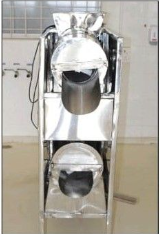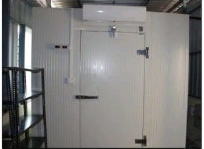SS Racks

SS racks for cold rooms typically refer to stainless steel racks designed specifically for use in cold storage environments, such as walk-in refrigerators or freezers. These racks are chosen for their durability, resistance to corrosion, and ease of cleaning, which are important factors in environments where hygiene and temperature control are critical.
Here are some key points to consider when looking for SS racks for cold rooms:
-
Material: Stainless steel (SS) is preferred due to its resistance to rust and corrosion, making it suitable for cold and potentially humid conditions.
-
Design: Racks should have a design that allows for easy cleaning and airflow, which is crucial for maintaining temperature consistency throughout the cold room.
-
Size and Load Capacity: Choose racks that fit the dimensions of your cold room and can support the weight of your stored items without bending or warping.
-
Adjustability: Adjustable shelving allows you to customize the rack to accommodate different sizes and shapes of items.
-
Hygiene Standards: Ensure the racks meet hygiene standards required for food storage if they are used in food-related cold rooms.
-
Supplier: Purchase from reputable suppliers who can provide racks designed specifically for cold room use and offer support for installation and maintenance.
When selecting SS racks for a cold room, consider your specific storage needs, the dimensions of your cold room, and any regulatory requirements that may apply to your industry.
Pulper

A pulper is a key piece of equipment used in food processing, especially in industries like fruit and vegetable processing, as well as in the production of juices, jams, and sauces. Here are some key aspects and functions of a pulper:
-
Function: A pulper is designed to break down fruits or vegetables into a pulp or puree. This process involves crushing the raw material to extract the juice or liquid content while separating the solid parts such as seeds, skins, and fibers.
-
Components: Typically, a pulper consists of a rotating drum or cylinder with perforations or a mesh screen. The raw material is fed into the drum, which rotates and grinds the fruits or vegetables against the screen. The pulp passes through the screen, while larger particles like seeds and peels are retained and discharged separately.
-
Types: Pulpers can vary in size and complexity depending on the scale of production. They can range from small batch processing units suitable for artisanal production to large industrial machines capable of processing tons of raw material per hour.
-
Applications:
- Juice Production: Pulping is essential for extracting juice from fruits like apples, oranges, berries, etc.
- Sauce and Puree Production: Pulping is used in making sauces, purees, and concentrates for various culinary applications.
- Waste Management: Pulping can also be used in waste management systems to process organic waste and extract useful components like juice or pulp.
-
Operation: The operation of a pulper involves feeding the raw material into the inlet, where it is processed by the rotating drum or blades. The extracted pulp or juice flows through the screen while the solid waste exits separately.
-
Maintenance: Regular cleaning and maintenance of a pulper are crucial to ensure hygienic operation and prevent clogging or damage to the equipment.
In summary, a pulper is a versatile piece of equipment used extensively in food processing to extract juices, create pulps and purees, and manage organic waste efficiently. Its design and capacity vary widely to suit different production needs across the food industry.
Walk in Cold Room

Walking into a cold room can be quite an experience, depending on how cold it is and what you're dressed in. If you're not prepared, that sudden blast of cold air can be shocking. People often react by shivering or rubbing their arms to generate warmth. The sensation of the cold might also make you feel more alert or awake, as your body responds to the temperature change.
Walking into a cold room used for storing food products typically involves a few considerations:
-
Preparation: Ensure you're dressed appropriately with warm clothing, especially if the cold room is set to a low temperature.
-
Purpose: When entering a cold storage room for food products, the goal is usually to check inventory, rotate stock, or retrieve specific items. This helps maintain inventory freshness and organization.
-
Safety: Cold rooms are designed to keep food at safe temperatures to prevent spoilage and maintain quality. Be mindful of any safety protocols, such as closing doors properly to maintain temperature consistency.
-
Efficiency: Limiting the time the cold room door is open minimizes temperature fluctuations and energy loss, which is crucial for energy efficiency and food safety.
-
Hygiene: Maintain hygiene practices, such as wearing appropriate footwear and avoiding any cross-contamination between different food products.
Overall, walking into a cold room for food products involves understanding its purpose, maintaining safety and hygiene standards, and ensuring efficient operation to preserve food quality.
Pilot Spray Dryer

A pilot spray dryer serves as an intermediate-scale unit between laboratory-scale equipment and full-scale industrial spray dryers. It's typically used for research, development, and small-scale production purposes where larger quantities of dried product are needed compared to lab-scale, but not at the scale of industrial production. Here are some key aspects and considerations:
Key Features of a Pilot Spray Dryer:
-
Scale: Pilot spray dryers are designed to handle larger volumes of feed compared to laboratory-scale units, typically ranging from a few kilograms to tens of kilograms of feed per hour.
-
Flexibility: They offer flexibility in terms of process parameters such as inlet air temperature, atomization rate, feed flow rate, and drying chamber design. This allows for experimentation and optimization of drying conditions.
-
Ease of Use: Pilot spray dryers are designed to be user-friendly with intuitive controls for adjusting and monitoring parameters during operation.
-
Scale-Up Capability: They are crucial for scaling up processes from laboratory experiments to larger industrial production, helping to validate feasibility and optimize production parameters.
-
Product Quality Control: Pilot spray dryers enable researchers and engineers to control particle size distribution, moisture content, and other product characteristics, ensuring consistency and quality in dried products
Popular manufacturers of pilot spray dryers include Buchi, Yamato, GEA Niro, LabPlant, and Spraytec, among others. Choosing the right pilot spray dryer involves considering these factors to ensure it aligns with your research, development, or small-scale production objectives effectively.
Osmotic Dehydration of Fruit & vegetables
 Osmotic dehydration is one of the best methods to increase the shelf life of fruits and vegetables. This process retains vitamins, minerals, color, flavor and taste. Osmotic dehydration can remove 30-50% of the water from fresh ripe fruits and final product contains about 15% moisture with a shelf life of one year.
Osmotic dehydration is one of the best methods to increase the shelf life of fruits and vegetables. This process retains vitamins, minerals, color, flavor and taste. Osmotic dehydration can remove 30-50% of the water from fresh ripe fruits and final product contains about 15% moisture with a shelf life of one year.
Amla Squash & Guava Squash

Osmotic dehydration is one of the best methods to increase the shelf life of fruits and vegetables. This process retains vitamins, minerals, color, flavor and taste. Osmotic dehydration can remove 30-50% of the water from fresh ripe fruits and final product contains about 15% moisture with a shelf life of one year.
Fruit bar

Osmotic dehydration is one of the best methods to increase the shelf life of fruits and vegetables. This process retains vitamins, minerals, color, flavor and taste. Osmotic dehydration can remove 30-50% of the water from fresh ripe fruits and final product contains about 15% moisture with a shelf life of one year.
Fruit Bar Technology

Concentrated and dehydrated fruit Product Prepared from fruit pulp The product is nutritious and retains colour, flavour and taste similar to that of fresh fruits during storage The product can serve as an alternative to chocolates and sugar candies Suitable venture for FPOs, Start-ups, Entrepreneurs, MSME and Food Processing Industry Suitable for people of all ages. Highly suitable for children, youth, sports fraternity, mountaineers and defense forces Shelf life : 6 months or more under room temperature depending on packaging
Raw mango slice preservations

- Raw mangoes slices/cubes can be stored for an year or more retaining their colour, texture and flavor
- Ideal for making Mango pickle and chutney
- A good venture for SHG, start-ups and entrepreneurs Approval & Certifications Required: FSSAI
Minimally Processed Onion

- Minimally processed Shelf life of 13 days at 8°C
- Ease and convenience
- A good venture for entrepreneurship development, and for FPOs and MSMEs Approval & Certifications required: FSSAI
Individual shrink wrapping technology
 The target end users of these technologies include start-ups, women, commercial growers,
wholesale dealers, exporters, start-ups.
The target end users of these technologies include start-ups, women, commercial growers,
wholesale dealers, exporters, start-ups.
- A packaging technique involves use of a flexible film
- Extends shelf life of non-climacteric and climacteric fruits and vegetables
- Avoids secondary infections
- Maintains freshness and firmness upto 2-3 weeks at room temperature and 10 to 12 weeks at 8°C
- Ideal for Consumer appeal and brand identification
- Suitable for retail outlets and vending vans

